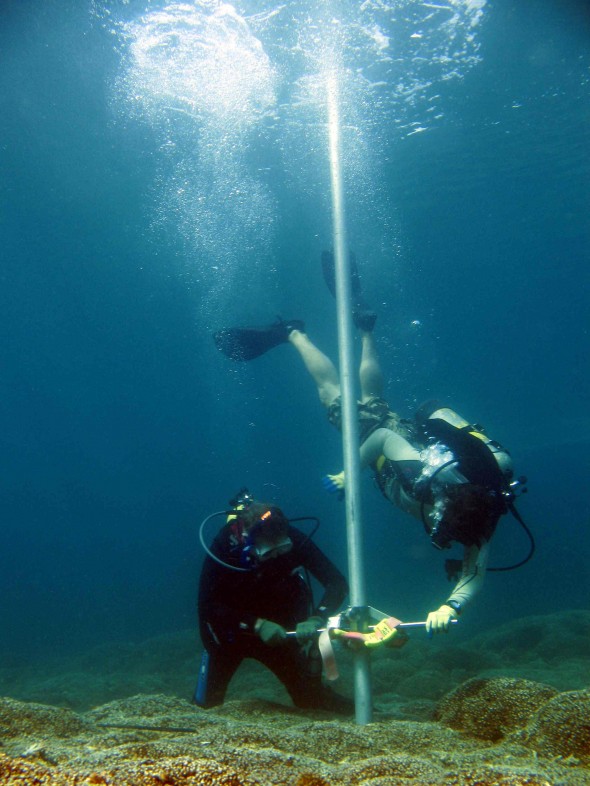Like so many other ecosystems, coral reefs are being greatly impacted by climate change. Greenhouse gases are trapping excess heat from the sun, and more than anything, are warming the oceans from tropical reefs to deep polar seas.
Reef corals are sensitive to small amounts of warming. An increase of just a degree or two Fahrenheit can cause corals to “bleach” and can promote lethal coral disease outbreaks. The mechanisms underlying the link between warming and coral death are well-understood, we have countless case studies of how warming reduces coral populations, and we’ve even quantified this relationship:
The annual effect of temperature anomalies (weeks that were > 1 °C warmer than usual) on the change in living coral cover when coral cover is initially 50%. The 95% confidence intervals (thin black line), 50% intervals (thick gray line), and point estimates (median) of the posterior distributions are shown. Results are based on a multilevel model analysis of 8040 live coral cover surveys performed around the world between 1985 and 2005. From Fig. 4B in Selig et al. 2012 source / PDF
Despite this mountain of evidence, there is a rift within the scientific community over the threat of climate change to coral reefs — many of my colleagues view local “stressors” including overfishing and pollution to be the real cause of declining coral populations. They argue that corals are only affected by climate change when reefs are overfished and that we can restore reefs and protect them from threats like warming, disease, and acidification with local management and essentially ignore carbon emissions.
…changes in climate are unlikely to be the primary reason for microbial outbreaks and disease. – Jackson et al. 2001
All reefs were substantially degraded long before outbreaks of coral disease and bleaching. – Pandolfi et al. 2003
Regardless of the severity of increasing threats from pollution, disease, and coral bleaching, our results demonstrate that coral reef ecosystems will not survive for more than a few decades unless they are promptly and massively protected from human exploitation [fishing]. – Pandolfi et al. 2003
…local protection can make reefs resilient to the impacts of global change. – Nancy Knowlton source
Caribbean reef degradation predates coral bleaching and disease outbreaks linked to anthropogenic climate change.- Cramer et al 2012
These results…highlight the importance of managing local impacts such as fishing and land clearing to stem the tide of reef decline.- Cramer et al 2012
Very little if any actual science supports these views, that are likely based more on ideology and academic politics. Regardless, the tide is turning. A growing, yet still minority, renegade group of coral reef scientists seem to be changing minds that matter about what we need to do to save and restore the world’s coral reefs. A major turning point was the 2010 publication of NOAA’s “Status Review Report” evaluating a petition to list 82 additional corals under the ESA. The report found:
After extensive review of available scientific information, the BRT [Biological Review Team] considers ocean warming, disease, and ocean acidification to be the most influential threats in posing extinction risks to the 82 candidate coral species between now and the year 2100.
This definitive statement represents a sea change in the positions of both the US government and coral reef scientists about the threat posed by climate change to coral reef ecosystems. I participated in a scientific workshop about the threats to corals related to the Status Review Report last week and I was struck by the broad consensus in support of this statement and the need to immediately begin to reduce greenhouse gas emissions.
Today a new paper (Toth et al. 2012) from a team led by coral reef paleoecologist Dr Rich Aronson of Florida Tech added to the body of research that points to the “primacy” of climate change in the battle to save reefs.
Aronson’s team used a technique called push-coring , which allows reef ecologists to essentially go back in time to examine the history of a reef thousands of years into it’s past. Long aluminum tubes are crammed into the reef (as in the photo below), a core is extracted, and the contents (mainly coral skeletons) are identified and dated using radiocarbon analyses and other dating techniques. Reefs leave a record of their past experiences, like the rings in a tree. This history can be read to decipher what the environment was like in the past (e.g., temperature and storm frequency). The team found that a natural climatic shift (likely in ENSO variability) halted reef growth in the eastern Pacific for 2,500 years beginning nearly 4000 years ago. (read more about the study here)
This finding indicates that, as we know from paleoecological studies of earlier eras, our modern coral reefs are supremely sensitive to subtle changes in climate even in the absence of local impacts like fishing and pollution.
In other words, in contrast to what has been argued in a number of high profile essays (also in Science magazine), reefs do not have to be overfished and polluted to be harmed by climatic fluctuations. And the findings of Toth et al. are very much concordant with a growing body of literature indicating that local management does not measurably reduce the impacts of climate change on reefs. Also see here.
Everyone agrees that overfishing, particularly the depletion of predators from coral reef ecosystems, is an enormous, global problem. But the current science indicates that this problem is largely unrelated to the climate change problem. We urgently need to tackle both problems simultaneously and with equal vigor and commitment. Unfortunately, solving one will not negate the other.
Authors (Left to right) Ian Macintyre and Steven Vollmer force aluminum core tube into a reef framework. Photo credit: Richard Aronson.


Leave a Reply to Rob Painting Cancel reply